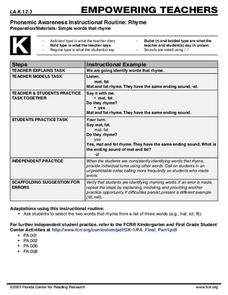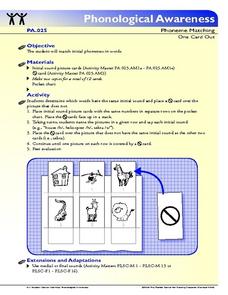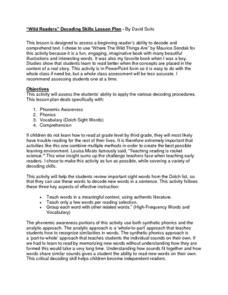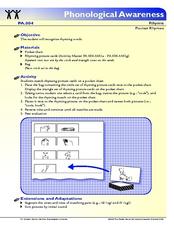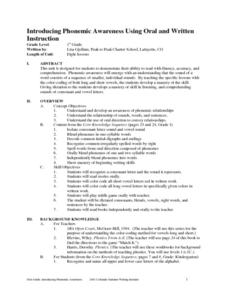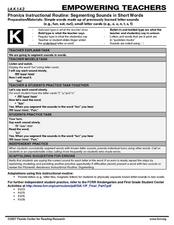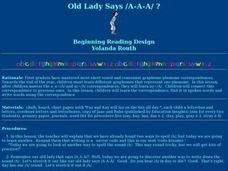Curated OER
The Icky Sticky Frog
Learners practice the strategy of phoneme awareness in order to identify phonemes with vocal gestures in spoken words. They blend letters and sounds together utilizing the phoneme /i/ by symbol and letter representation and listen as the...
Curated OER
Using the Sounds of Words Reading Task
Young readers demonstrate phonemic awareness in words and blends, and recognize 100 high-frequency words. Use a nursery rhyme to point out rhyming words, and change the words by putting a new letter at the beginning. Each learner will...
Curated OER
Alphabet Tic-Tac-Toe
Use online resources to aid young readers' phonemic awareness. They will look at various sources to practice letter-sound relationships. They also are assessed using a rubistar rubric. Quite a few resources are given for this lesson.
Literacy Connects
Activities to Build Phonological Awareness
Begin your reading program each day with a mini lesson on phonological awareness using these engaging activities listed in the resource. Young ones will enjoy word families, clapping and counting syllables, identifying single sounds and...
Curated OER
Aaaa! It's A!
Exercise phonemic awareness of the vowel /a/ to help children become successful readers. They connect spoken phonemes to written grapheme's and create a relationship between the vocal gesture of /a/ and its grapheme map in text and words.
Florida Center for Reading Research
Phonemic Awareness Instructional Routine: Rhyme
As a class, kindergarteners identify rhyming words. The teacher provides an example of a rhyming pair and explains why they rhyme. Individual learners then respond by saying a word that rhymes with a given word.
Florida Center for Reading Research
One Card Out
Remember the song, "One of These Things is not Like The Other?" Well, this phonemic awareness activity is just like that. The only difference is that learners work to determine which initial phoneme is not like the others on the chart....
Florida Center for Reading Research
Word Blender
Little learners will love being able to blend sounds together to make words. This game provides eight onsets and eight rimes that can be used to mix and match to sound out words. This activity is to be completed in pairs and is a great...
Kindergarten Mom
Animal Alphabet Chart
Engage young children in learning the letters of the alphabet with a fun animal alphabet chart. With the letters written in both upper and lower case and accompanied by pictures of animals beginning with each letter, this is a great...
Curated OER
Rainbow Spelling: A Kinesthetic Approach to Encoding
Have your young learners interact with phonemes through this tactile plan! Each learner will have a colored mat where they connect different phonemes to create words. The best part is that they can self-correct easily as they spell!
Florida Center for Reading Research
Rhyme Pie
Being able to recognize rhyming words is a step closer to understanding the phonemic blends that are necessary for building early reading skills. Little learners use the provided picture cards to make a rhyming pie. They glue rhyming...
Curated OER
Ehhh...What'd you say?
Practice pronouncing and spelling words with the /e/ sound with spellers. They blend phonemes with spelling maps to master important representation and letter symbol of the short vowel /e/. They also make sock puppets and study the...
Florida Center for Reading Research
Phonics: Letter-Sound Correspondence, Letter-Sound Pyramid
This fun game is a way to help your littlest learners build strong phonological awareness. Scholars equipped with letter triangles, a stack of picture cards, and counters choose a picture card, say the name of the image, and attempt to...
Curated OER
Oh Say Can You DDDD!
Young readers see that letters represent phoneme sequences in spoken words. They identify the letter "d," and recognize "d" in spoken words by exploring the meaningful representation and a letter symbol. They practice finding the letter...
Curated OER
Drum Roll, Please!
Drill and practice phonemes, letter formations, written language, vowel correspondences, as well as consonant correspondences with youngsters. They will locate and identify the /b/ in written and spoken words from flash cards containing...
David Suits
“Wild Readers” Decoding Skills Lesson Plan
Set young readers on the path toward fluency with this phonemic awareness resource. Based on the award-winning children's book, Where the Wild Things Are, this lesson plan allows beginning readers to practice isolating phonemes and...
Florida Center for Reading Research
Fluency: Letter-Sound Correspondence, Fluency Letter Wheel
Young scholars spin their way to letter sound fluency. While tomes, pairs spin a spinner and make the sound of the letter on which it lands. They add a counter to their cup for each sound they make correctly. At the end of the game,...
Florida Center for Reading Research
Picture Slide
Here is another fun and engaging way to help youngsters build phonological awareness. In pairs, they use the provided picture cards to sound out segments of words. As they slide the picture together they say a segment of the...
Florida Center for Reading Research
Pocket Rhymes
Rhyming is fun and it helps build phonological awareness that is key in early reading. Learners use a pocket chart and a set of 40 cards that make 20 rhyming sets to practice recognizing rhyming words. Peer one picks a card from a bag...
Curated OER
Introducing Phonemic Awareness Using Oral and Written Instruction
First graders demonstrate their ability to read with fluency, accuracy, and comprehension through phonemic awareness. They use a color-coding system to master the long and short vowel sounds and develop their skills in listening and...
Curated OER
Phonics: Segmenting Sounds in Short Words
F-u-n spells fun. It is a simple word that little learners can sound out as they build phonemic awareness and those early reading skills. This short scripted lesson provides teachers with the basics for teaching how to sound out words.
Curated OER
"Uhh..Did I do that?" - Phonemic Awareness
Students practice using the letter u in order to understand letter-sound correspondence. In this letter-sound correspondence lesson plan, students write, read, and say different words with the letter u in them.
Florida Center for Reading Research
Phonological Awareness: Phoneme Segmenting and Blending, Picture Slide
A hands-on activity challenges young scholars to name a picture, segment its phonemes, then blend those sounds to make the word.
Curated OER
Old Ladies Say A?
The letter a produces so many sounds! Increase your class's awareness of concepts related to reading and spelling. They identify the digraphs /ea/ and /ai/ in spoken language and spelling as a long vowel sound. After a brief discussion,...
Other popular searches
- Phonemic Awareness
- Phonemic Awareness Lessons
- /A/ Letter Sound Recognition
- Phonemic Awareness Practice
- Phonemic Awareness Games
- Phonemic Awareness Letter K
- Phonemic Awareness Matching
- Phonemic Awareness Art
- Sound Recognition
- Phonemic Awarness
- Letter Sound Recognition
- Phonemic Awareness Activities







